-
Car Reviews
- All reviews
- Midsize SUVs
- Small cars
- Utes
- Small SUVs
- Large SUVs
- Large cars
- Sports SUVs
- Sports cars
- Vans
Latest reviews
- Car News
-
Car Comparisons
Latest comparisons
- Chasing Deals
The highly-anticipated eighth-generation Volkswagen Golf has now arrived in Australia – and it’s still the well-judged small car it always has been.

The arrival of a new Volkswagen Golf is an epoch-level occasion for the motoring industry.
More than just about any other vehicle, the Golf defines a segment. Other small cars are judged by how close they come to Volkswagen’s long-running badge. For decades, the Golf has been a hatchback with a target on its back, benchmarked by the Toyota Corolla, Hyundai i30, Mazda 3 and Ford Focus in recent years.
And while those rivals have drawn closer than ever, the 2021 Volkswagen Golf in eighth-generation “Mk 8” form re-establishes itself as the class leader, though with a greater amount of reservation than when the outgoing Mk 7 Golf swept a field of much less sophisticated rivals.
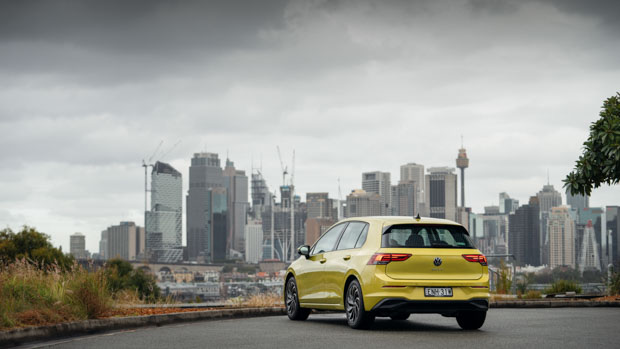
Even today, few of the Golf’s competitors use as sophisticated a turbo engine – even if the one Volkswagen have been forced to use in Australia is the same 1.4-litre unit from the Mk 7. The factory in Germany simply won’t build the latest VW engines, which are even quieter and more economical, for Australia’s high-sulphur fuel that is not set to be upgraded until 2024 at the soonest.
The new Golf arrives in Australia with a simplified – and more expensive – lineup of variants.
There is a better-equipped base model known simply as Golf (from $29,350). The car on test here is the mid-tier Life ($34,250) that replaces the previous Comfortline ($29,790). The Highline is gone, replaced at the top of a standalone Golf R-Line ($37,450). And the Golf GTI hot hatch has returned with a $53,100 tariff. Prices are up, but so is standard equipment.
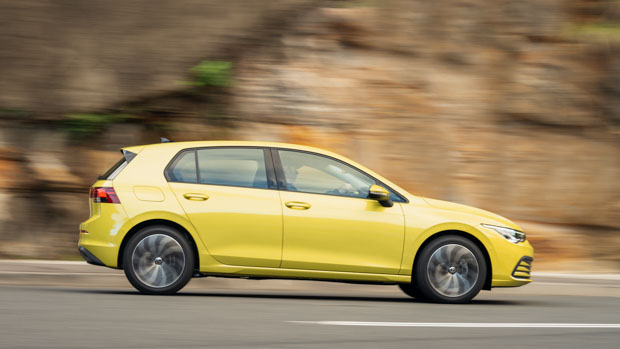
While it looks familiar, the Mk 8 Golf is born to a Volkswagen Group juggling far more balls in the air than when its predecessor launched in 2013 – a year that seems long ago and significantly simpler than 2021.
The Group is busily establishing the ID electric vehicle line, developing autonomous driving features (some launching in this Golf), the burden of emissions penalties continue to appear on balance sheets, and in Australia, the Group will soon introduce the new Cupra brand. All these tasks have given rise to concerns that core models like Golf have fallen in the priority list.
A drive of the Mk 8 Golf dispels nearly all of that anxiety, as you discover this key vehicle remains well-built and well-judged: premium for the people, as Volkswagen say. Look a little closer, though, and some evidence of lower production costs emerge: a bit more plastic, a bit less flock-lining, and the replacement of hydraulic bonnet struts with a mechanical rod.
But beyond these moments, how do the fundamentals of the new Golf rate?
Because the new Golf uses the same platform and engine as the previous model, there are many similarities behind the wheel.
That said, there are also some big differences. There is a totally different kind of automatic gearbox, for starters, and the Mk 8 Golf has benefitted from some additional refinements compared to the older Mk 7.
Putting it simply, the Volkswagen Golf is the best small car to drive. It is more comfortable and cohesive than its rivals, with a creamy ride quality, superb bump absorption, and spot-on steering feel. And it achieves all of that without adjustable drive modes.
Unlike the more customisable Golf R-Line and GTI models, the Golf Life does not have variable dampers or adjustable steering. There is just one setting but it is the right one. The steering is moderately quick and mid-weighted; the wheel twirls easily when parking but firms up intuitively at high speeds.
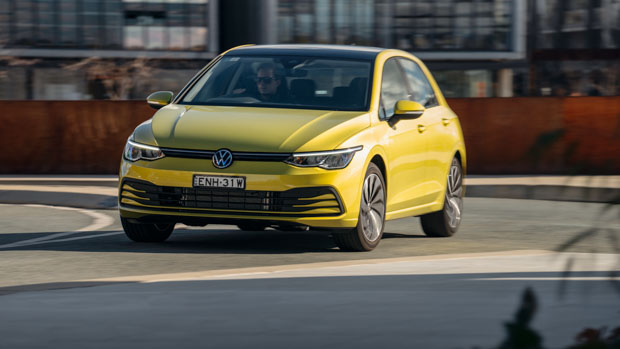
Meanwhile, the Golf’s true independent rear suspension (IRS) gives it a leg up on the less sophisticated ride of the Mazda 3 and Ford Focus, and the Golf’s expertly-tuned suspension is even better than the IRS found on the Hyundai i30 N Line and Toyota Corolla.
There’s an immediate perception that the Golf ‘just works’. There are no uncomfortable thumps or bumps from the 17-inch wheels, and the control surfaces feel consistent.
Push on and you’ll discover that the Golf seems to be imbued with the dynamic spirit of the GTI even in the lesser grades. There is a sort of warm-hatch demeanour to the handling, with high grip levels, a well-balanced and playful chassis, and confidence-inspiring steering that encourages you to seek out B-roads.
The Golf is a driver’s car, but it doesn’t force compromises like an overtly sporty ride quality. That is a very rare combination.
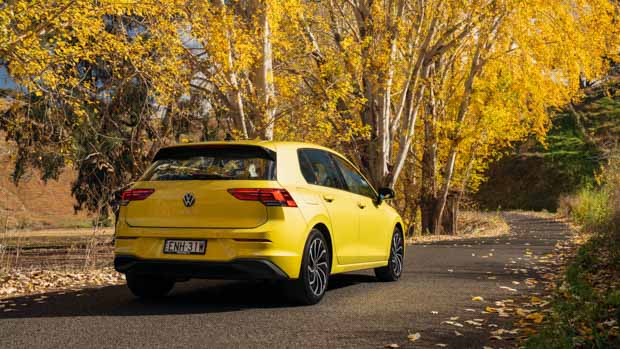
We have similar praise for the carry-over 1.4-litre turbocharged petrol four-cylinder engine. Every Golf bar the new GTI, and forthcoming Golf R, produces the same 110kW of power and 250Nm of torque. Just like the old one. That’s because newer Golf engines are not compatible with high-sulphur Australian fuel, VW says.
The engine not being new doesn’t count against the Golf. That is because the 1.4-litre is still the best engine in the segment. It has plenty of pulling power for overtaking while delivering acceptable fuel consumption of about 7.5L/100km combined. Plus, it’s quiet, smooth and refined.
Rivals like the Hyundai i30’s 1.6-litre turbo, the 1.5-litre turbo in the Ford Focus and the 2.5-litre in the Mazda 3 come close, but none dethrone the mighty ‘EA211’ engine. Not yet, at least.
The biggest change dynamically in the new Golf is that the previous car’s dry dual-clutch automatic transmission has been removed and replaced by an eight-speed conventional torque converter auto.

For some, this change will be welcome, because the torque converter Golf delivers the engine’s power more like a Mazda 3 or Hyundai i30. That is, the gearbox is a classic stepped auto without the complexity of a faster dual-clutch system.
And, most of the time, the new Golf delivers just that – but the new auto is not calibrated especially well. In first and second gears, it has a tendency to get over-excited with moderate throttle input and rev all the way out, way past the point where the engine has useful torque.
The old car’s DSG gearbox had been refined so much that it was no longer the ‘quirky’ dual-clutch journalists and some owners once bemoaned. It was slicker than the new auto-box.
The DSG continues in the European-specification Golf, where it serves with a newer 1.5-litre turbo petrol engine. With an upgrade to Australian petrol coming in the next 3 years, it is possible that at facelift time, our Golf will revert to a DSG gearbox. We would welcome that.

Significantly, all new Mk 8 Golf variants now come standard with a good suite of advanced safety technologies.
Volkswagen’s swish new Travel Assist feature is fitted range-wide. This combines radar-driven adaptive cruise control with strong lane centring and blind spot monitoring for less tiresome driving on highways – and it works quite well, though we had a number of warnings that our hands weren’t on the wheel, even though they were.
High and low-speed forwards AEB is standard, as is reversing AEB and oncoming vehicle or junction AEB. Automated parking makes its return as a standard Golf feature, while driver fatigue detection, low tyre pressure warning, auto headlights and auto wipers are all standard. You get a reversing camera but no 360-degree camera is available.
Volkswagen have made a clear attempt to make the Golf’s interior to be much more tech-forward and fashionable than the last car, which was more conservative in design.
In fact, the interior design of the Mk 8 Golf is perhaps the biggest change when comparing this Volkswagen to its predecessor.
Many of the changes are positive. The chunky new steering wheel looks great and feels absolutely delightful. There is a deep feeling of quality in the dashboard and door plastics, which are actually more generous than on the Mk 8. And by pushing that dash forward, the Golf Mk 8 feels more roomy and airy than the car it replaces.
And the seats are even better than the old car. The ‘Life’ specification is more or less a replacement for the Mk 7.5 Golf Comfortline, but the Life can be had with optional sports seats as fitted to our tester. They remain manually adjustable, but there is excellent support, considerable lumbar adjustment and the driving position feels right.
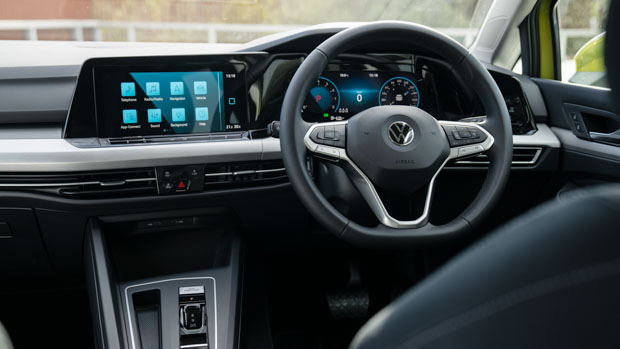
But what about the new screens that dominate the dashboard? Making up what Volkswagen calls the “Innovision Cockpit” are two ten-inch displays: a new generation of the ‘Virtual Cockpit’ digital driver display controlled via the steering wheel, plus a new central touchscreen that is inclined toward the driver. The base model has a smaller eight-inch unit.
Let’s start with the good – the new Virtual Cockpit. Simpler to operate than it was on the old Golf, this system works fantastically well, with three ‘panels’ of fully customisable data. If you want a map, your media choices and your trip computer data all viewable at the same time – you can have that. No rival bar the related Skoda Scala offers this.
Or you can banish all the distractions and just place a crisp, high-resolution map in front of you, allowing you to read the road ahead like a sixth sense. Basically, Volkswagen do digital gauges better than anyone.
As for the bad – that would be the new Golf’s central touchscreen.
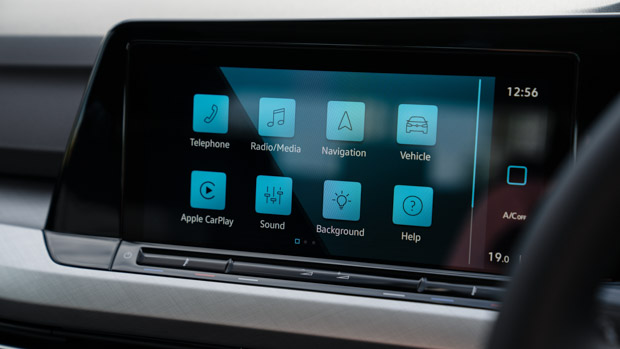
The basic software itself is pretty much fine, with a clear layout and simple menu structure. The problem is the responsiveness of the screen. It’s so laggy at times you wonder if Volkswagen cut corners on the hardware behind it. Is there insufficient processing power?
Then there is the fact some touch targets are ridiculously small. Want to drag across into the Now Playing panel? Need to drag down to access the new Shortcuts menu? You’ll need extreme precision while driving down a bumpy road.
The new screen is helpfully higher-set, but the elegant simplicity of the operating system on the old model’s touchscreen are missed.
After a couple of days of cursing, though, we came to a settlement with the Golf. You can easily set up the Virtual Cockpit just how you’d like it – and helpfully, the middle screen is equipped with wireless Apple CarPlay and wireless Android Auto from the Life upward, so we allowed CarPlay to take over the main screen at all times. The red mist disappeared.
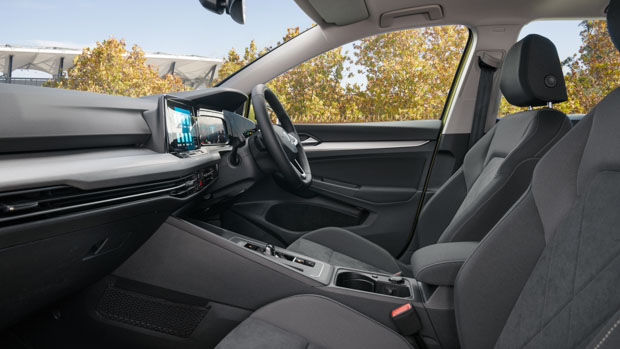
Still, the half-baked touchscreen is an annoying blight on an otherwise segment-leading cabin. The packaging is superb, with heaps of space in both rows despite the fact the Golf is usefully smaller and easier to live with in the city than most of its rivals.
Standard equipment is quite generous. LED headlights, tri-zone climate control and 4 USB ports are fitted in every Golf, though the Life really steps up the kit with 10-colour ambient lighting, keyless access to the front doors and boot, push-button start, and comfort seats.
There is storage space aplenty, with a box beneath the ergonomic, adjustable armrest, plus an expansive cup holder space, huge flock-lined door bins, and a tray ahead of the shifter with wireless phone charging.
Our Life tester was fitted with the $2,000 Comfort & Style package that adds sportier microfleece front seats, 30-colour ambient lighting, and a sunroof. A $1,500 Sound & Vision package adds a punchy Harman-Kardon stereo and a head-up display.
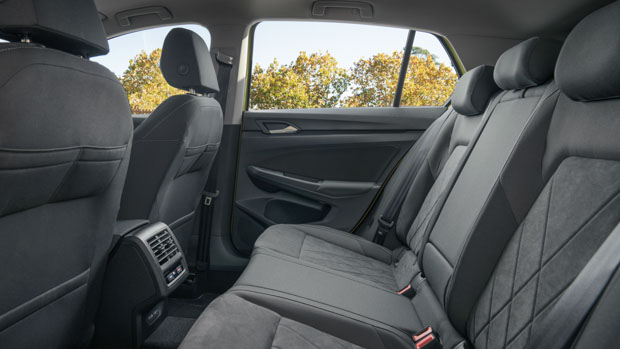
Most concerns that the Golf Mk 8 would go backwards in terms of quality are unfounded … aside from a few areas. The plastics around the new automatic gear shifter feel a bit low-rent and it’s possible the front doors aren’t quite as tank-like as they once were. But by and large, the Golf feels solid.
Back seat space continues to be plentiful for two adults taller than six-foot, though the middle seat remains a perch. Air vents are standard, as is a separate temperature zone, an armrest, and a pass-through to the 381 litre boot that measures a litre bigger than the Mk 7.5.
Still, that cargo space is cleverer than most, with a dual-height boot floor, a (space saver) spare, bag hooks, a sturdy cargo cover, and easy reach to the 60/40 rear seat folding mechanism.
Next month, a larger Golf Wagon will make its return to the Australian market for buyers seeking a higher degree of practicality.
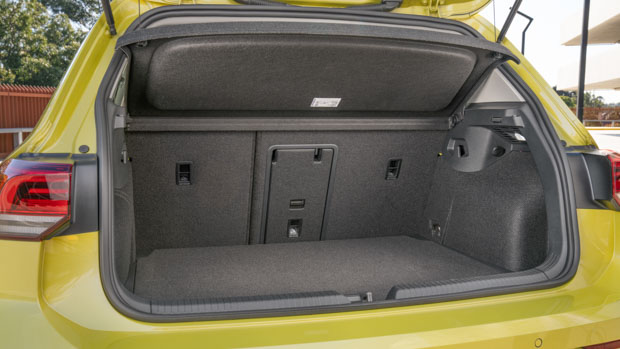
The costs of owning and running a Golf are limited thanks to a frugal engine and reasonably affordable servicing – though maintenance is cheapest if you buy a servicing pack up front.
Servicing the Golf needs to be done every 12 months or 15,000 kilometres – whichever comes first – and you can either pay when work is due or you can score a discount by purchasing a ‘care plan’ when you first buy the car.
A three-year service pack costs $1,200, while five years of coverage costs $2,100. The latter helps to minimise the impact of the Golf’s intensive (and costly) fourth-year service. The packs are transferrable to a new owner.
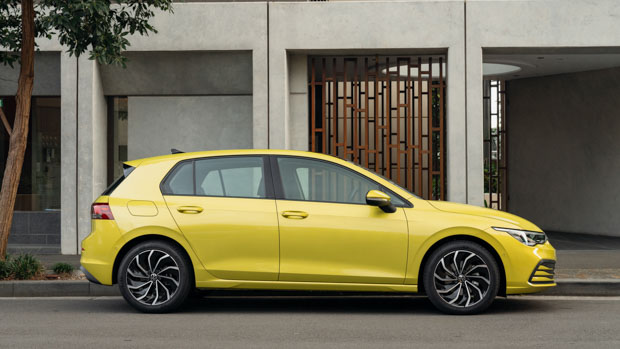
So is the warranty, which like all Volkswagen cars sold in Australia, provides coverage for five years with unlimited kilometres in that period.
The Golf’s fuel consumption is acceptable for the performance on offer. On the highway it will deliver less than 6L/100km, while in town we saw around 8L/100km. Over our week of testing, consumption settled at about 7.5L/100km.
Keep in mind, though, that the Golf requires 95-octane premium petrol at a minimum.
We highly recommend the Volkswagen Golf.
As our review makes plain, the Mk 8 Golf isn’t perfect. We have bugbears with the touchscreen and we preferred the old dual-clutch gearbox.
But on virtually every other metric, the new Golf continues to set a high benchmark for other small cars to aim for.
The Golf rides beautifully, it has power in reserve, it has frugal consumption and reasonably low running costs, and it provides a slice of luxury refinement at prices that are still accessible, even if they have crept up compared to the great-value Mk 7.5.
Forthcoming wagon and R models will serve to further increase the new Golf’s bandwidth and we look forward to evaluating them in due course.
Variant tested 110TSI LIFE
Key specs (as tested)
About Chasing cars
Chasing Cars reviews are 100% independent.
Because we are powered by Budget Direct Insurance, we don’t receive advertising or sales revenue from car manufacturers.
We’re truly independent – giving you Australia’s best car reviews.
The estimate provided does not take into account your personal circumstances but is intended to give a general indication of the cost of insurance, in order to obtain a complete quote, please visit www.budgetdirect.com.au. Estimate includes 15%^ online discount.
^Conditions Apply
Budget Direct Insurance arranged by Auto & General Services Pty Ltd ACN 003 617 909(AGS) AFSL 241 411, for and on behalf of the insurer, Auto & General Insurance Company Limited(ABN 42 111 586 353, AFSL 285 571).Because we don’t know your financial needs, we can’t advise you if this insurance will suit you. You should consider your needs and the Product Disclosure Statement before making a decision to buy insurance. Terms and conditions apply.
Indicative quote based on assumptions including postcode , 40 year old male with no offences, licence suspensions or claims in the last 5 years, a NCD Rating 1 and no younger drivers listed. White car, driven up to 10,000kms a year, unfinanced, with no modifications, factory options and/or non-standard accessories, private use only and garaged at night.
^Online Discounts Terms & Conditions
1. Discounts apply to the premium paid for a new Budget Direct Gold Comprehensive Car Insurance, Third Party Property Only or Third Party Property, Fire & Theft Insurance policy initiated online on or after 29 March 2017. Discounts do not apply to optional Roadside Assistance.
2. Discounts do not apply to any renewal offer of insurance.
3. Discounts only apply to the insurance portion of the premium. Discounts are applied before government charges, taxes, levies and fees, including instalment processing fees (as applicable). The full extent of discounts may therefore be impacted.
4. We reserve the right to change the offer without notice.